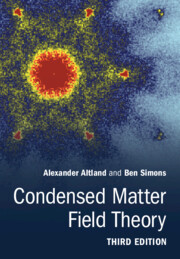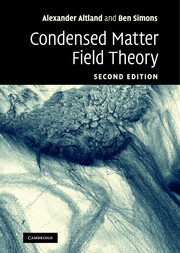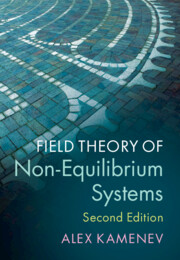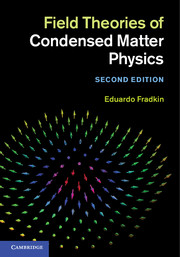Condensed Matter Field Theory
3rd Edition
- Authors:
- Alexander Altland, University of Cologne
- Ben Simons, University of Cambridge
- Date Published: September 2023
- availability: Temporarily unavailable - available from TBC
- format: Hardback
- isbn: 9781108494601
Hardback
Other available formats:
eBook
Looking for an inspection copy?
This title is not currently available for inspection. However, if you are interested in the title for your course we can consider offering an inspection copy. To register your interest please contact [email protected] providing details of the course you are teaching.
-
The methods of quantum field theory underpin many conceptual advances in contemporary condensed matter physics and neighbouring fields. This book provides a praxis-oriented and pedagogical introduction to quantum field theory in many-particle physics, emphasizing the application of theory to real physical systems. This third edition is organized into two parts: the first half of the text presents a streamlined introduction, elevating readers to a level where they can engage with contemporary research literature, from the introduction of many-body techniques and functional integration to renormalization group methods, and the second half addresses a range of advanced topics including modern aspects of gauge theory, topological and relativistic quantum matter, and condensed matter physics out of thermal equilibrium. At all stages, the text seeks a balance between methodological aspects of quantum field theory and practical applications. Extended problems with worked solutions provide a bridge between formal theory and a research-oriented approach.
Read more- Takes a first principles approach that assumes minimal existing knowledge of quantum field theory and its application in the condensed matter setting
- Develops concepts using a problem-based approach and illustrates ideas using applications from condensed matter, making the text suitable for graduate courses
- The revised edition of the text now includes more advanced and topical subject areas, equipping young scientists with a repertoire of concepts and methodologies in field theory
Customer reviews
Not yet reviewed
Be the first to review
Review was not posted due to profanity
×Product details
- Edition: 3rd Edition
- Date Published: September 2023
- format: Hardback
- isbn: 9781108494601
- length: 825 pages
- dimensions: 260 x 182 x 44 mm
- weight: 1.84kg
- availability: Temporarily unavailable - available from TBC
Table of Contents
Preface
Part I. 1. From particles to fields
2. Second quantization
3. Path integral
4. Perturbation theory
5. Broken symmetry and collective phenomena
6. Renormalization group
7. Response functions. Part II. 8. Topological field theory
9. Relativistic field theory
10. Gauge theory
11. Nonequilibrium (classical)
12. Nonequilibrium (quantum)
Appendix
Index.
Sorry, this resource is locked
Please register or sign in to request access. If you are having problems accessing these resources please email [email protected]
Register Sign in» Proceed
You are now leaving the Cambridge University Press website. Your eBook purchase and download will be completed by our partner www.ebooks.com. Please see the permission section of the www.ebooks.com catalogue page for details of the print & copy limits on our eBooks.
Continue ×Are you sure you want to delete your account?
This cannot be undone.
Thank you for your feedback which will help us improve our service.
If you requested a response, we will make sure to get back to you shortly.
×








